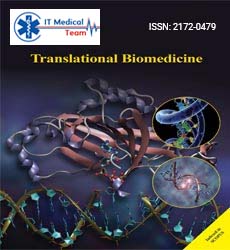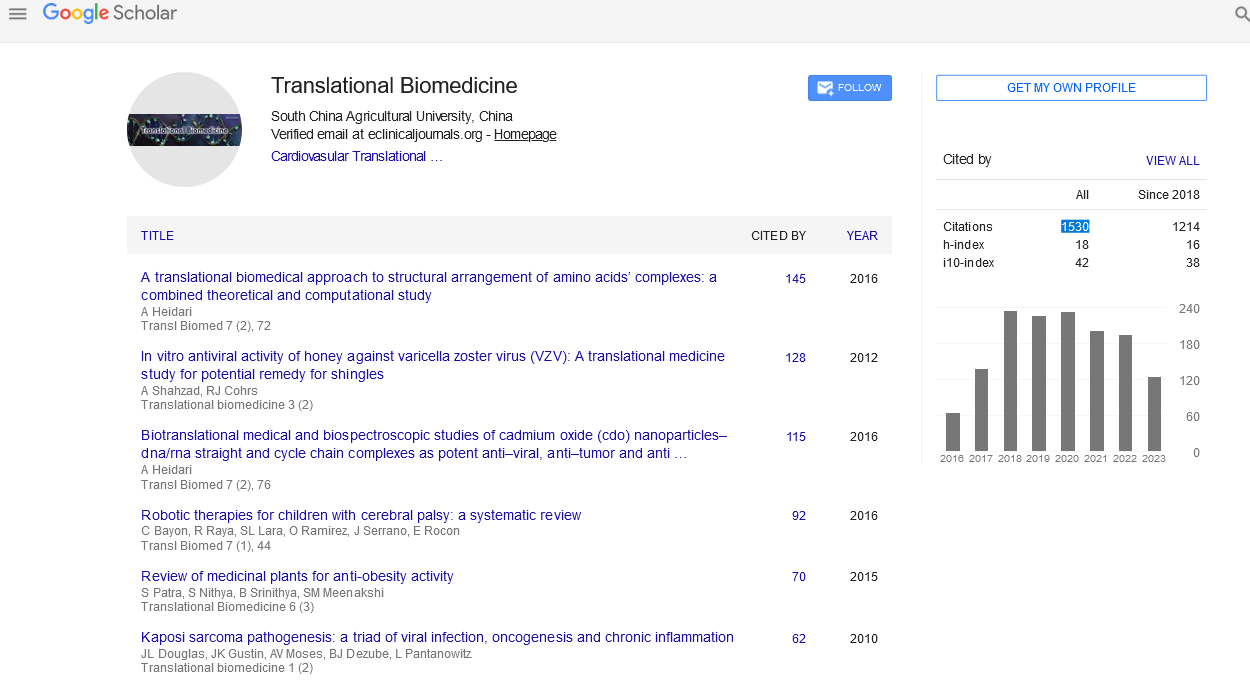Perspective - (2024) Volume 15, Issue 5
Translational Research Methodologies: Bridging the Gap between Laboratory and Clinic
Fan Wang*
Department of Biomedicine, Medical University, Wuhan, China
*Correspondence:
Fan Wang, Department of Biomedicine, Medical University, Wuhan,
China,
Email:
Received: 10-Sep-2024, Manuscript No. IPTB-24-15181;
Editor assigned: 13-Sep-2024, Pre QC No. IPTB-24-15181 (PQ);
Reviewed: 27-Sep-2024, QC No. IPTB-24-15181;
Revised: 01-Oct-2024, Manuscript No. IPTB-24-15181 (R);
Published:
29-Oct-2024
Introduction
Translational research stands at the intersection of laboratory
discoveries and clinical application, aiming to expedite the
process of bringing innovative therapies and diagnostics from
bench to bedside. This field encompasses various methodologies
designed to bridge the gap between fundamental scientific
research and practical medical applications.
Description
By transforming laboratory findings into real-world solutions,
translational research seeks to improve patient outcomes and
advance healthcare. This article explores key methodologies in:
Preclinical studies
Preclinical studies are foundational in translational research,
involving the investigation of new drugs, therapies or diagnostic
tools using laboratory models. These studies typically use cell
cultures, animal models or computational simulations to
evaluate the efficacy and safety of potential interventions before
they are tested in humans. Methodologies in preclinical research
include:
In vitro studies: These involve experiments conducted in a
controlled environment outside of a living organism, such as in
petri dishes or test tubes. In vitro studies help identify potential
targets and mechanisms of action for new therapies.
In vivo studies: These studies use live animal models to assess
the physiological effects and potential side effects of new
treatments. Animal studies provide insights into how a therapy
might behave in a complex biological system.
Pharmacokinetics and pharmacodynamics: These
methodologies analyze how drugs are absorbed, distributed,
metabolized and excreted in an organism, as well as their effects
on the body. Understanding these factors is crucial for
determining appropriate dosing and safety.
Clinical trials
Clinical trials are essential for evaluating the safety and
efficacy of new interventions in humans. They are typically
divided into four phases:
Phase I trials: Focus on assessing the safety, tolerability and
pharmacokinetics of a new intervention in a small group of
healthy volunteers or patients.
Phase II trials: Evaluate the efficacy and optimal dosing of the
intervention in a larger group of patients, often focusing on
specific disease conditions.
Phase III trials: Involve large-scale studies to confirm the
efficacy, monitor side effects and compare the new intervention
with standard treatments.
Phase IV trials: Conducted after the intervention has been
approved, these trials gather additional information on longterm
effects and effectiveness in diverse populations.
Clinical trials use various methodologies, including
Randomized Controlled Trials (RCTs), observational studies and
adaptive trial designs. RCTs are considered the gold standard for
assessing the effectiveness of new treatments, as they minimize
bias and provide robust data on intervention outcomes.
Biomarker development
Biomarkers are measurable indicators of biological processes,
pathogenic processes or pharmacologic responses. They play a
crucial role in translational research by enabling the
identification of disease states, predicting treatment responses
and monitoring therapeutic effects. Biomarker development
involves:
Discovery: Identifying potential biomarkers through highthroughput
screening techniques, such as genomics, proteomics
and metabolomics.
Validation: Confirming the relevance and reliability of
biomarkers through rigorous testing in clinical samples and
diverse populations.
Implementation: Integrating validated biomarkers into clinical
practice for diagnosis, prognosis and treatment monitoring.
Systems biology
Systems biology approaches aim to understand complex
biological systems through the integration of various data types,
such as genomics, transcriptomics, proteomics and
metabolomics. This methodology involves:
Data integration: Combining data from multiple omics layers
to create a comprehensive view of biological processes and
disease mechanisms.
Modeling: Developing computational models to simulate
biological systems and predict the effects of interventions.
Network analysis: Analyzing interactions between different
biological components, such as genes, proteins and metabolites,
to identify potential therapeutic targets.
Translational informatics
Translational informatics involves the application of data
science and computational tools to enhance the efficiency of
translational research. Key aspects include:
Data management: Organizing and storing large volumes of
data generated from clinical trials, preclinical studies and omics
research.
Bioinformatics: Using computational tools to analyze and
interpret biological data, such as sequencing data and gene
expression profiles.
Clinical decision support: Developing systems to assist
clinicians in making informed decisions based on evidence from
translational research.
Challenges and future directions
Translational research methodologies face several challenges,
including:
Regulatory hurdles: Navigating the complex regulatory
landscape for clinical trials and approval processes can be timeconsuming
and costly.
Funding constraints: Securing funding for translational
research, particularly for early-phase studies, can be challenging.
Integration of multi-omics data: Combining data from various
omics fields requires sophisticated computational tools and
expertise.
Conclusion
Translational research methodologies play a critical role in
transforming scientific discoveries into practical medical
solutions. By employing diverse approaches, from preclinical
studies to clinical trials and biomarker development, researchers
can bridge the gap between laboratory research and clinical
practice. Despite the challenges, ongoing advancements in
technology and collaborative efforts offer promising prospects
for accelerating the translation of research findings into
improved patient care and health outcomes.
Citation: Wang F (2024) Translational Research Methodologies: Bridging the Gap between Laboratory and Clinic. Transl Biomed. Vol.15 No.5: 048





